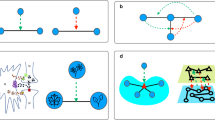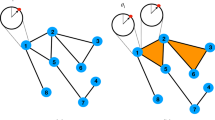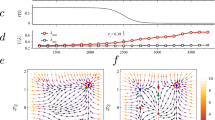Abstract
Higher-order networks capture the many-body interactions present in complex systems, shedding light on the interplay between topology and dynamics. The theory of higher-order topological dynamics, which combines higher-order interactions with discrete topology and nonlinear dynamics, has the potential to enhance our understanding of complex systems, such as the brain and the climate, and to advance the development of next-generation AI algorithms. This theoretical framework, which goes beyond traditional node-centric descriptions, encodes the dynamics of a network through topological signals—variables assigned not only to nodes but also to edges, triangles and other higher-order cells. Recent findings show that topological signals lead to the emergence of distinct types of dynamical state and collective phenomena, including topological and Dirac synchronization, pattern formation and triadic percolation. These results offer insights into how topology shapes dynamics, how dynamics learns topology and how topology evolves dynamically. This Perspective primarily aims to guide physicists, mathematicians, computer scientists and network scientists through the emerging field of higher-order topological dynamics, while also outlining future research challenges.
This is a preview of subscription content, access via your institution
Access options
Access Nature and 54 other Nature Portfolio journals
Get Nature+, our best-value online-access subscription
$32.99 / 30 days
cancel any time
Subscribe to this journal
Receive 12 print issues and online access
$259.00 per year
only $21.58 per issue
Buy this article
- Purchase on SpringerLink
- Instant access to full article PDF
Prices may be subject to local taxes which are calculated during checkout





Similar content being viewed by others
References
Barabási, A. L. Network Science (Cambridge Univ. Press, 2016).
Newman, M. Networks (Oxford Univ. Press, 2018).
Barrat, A., Barthelemy, M. & Vespignani, A. Dynamical Processes on Complex Networks (Cambridge Univ. Press, 2008).
Dorogovtsev, S. N., Goltsev, A. V. & Mendes, J. F. Critical phenomena in complex networks. Rev. Mod. Phys. 80, 1275 (2008).
Masuda, N. & Lambiotte, R. A Guide to Temporal Networks (World Scientific, 2016).
Bianconi, G. Multilayer Networks: Structure and Function (Oxford Univ. Press, 2018).
Giusti, C., Ghrist, R. & Bassett, D. S. Two’s company, three (or more) is a simplex: algebraic-topological tools for understanding higher-order structure in neural data. J. Comput. Neurosci. 41, 1–14 (2016).
Giusti, C., Pastalkova, E., Curto, C. & Itskov, V. Clique topology reveals intrinsic geometric structure in neural correlations. Proc. Natl Acad. Sci. USA 112, 13455–13460 (2015).
Petri, G. et al. Homological scaffolds of brain functional networks. J. R. Soc. Interface 11, 20140873 (2014).
Faskowitz, J., Betzel, R. F. & Sporns, O. Edges in brain networks: contributions to models of structure and function. Netw. Neurosci. 6, 1–28 (2022).
Santoro, A., Battiston, F., Petri, G. & Amico, E. Higher-order organization of multivariate time series. Nat. Phys. 19, 221–229 (2023).
Reimann, M. W. et al. Cliques of neurons bound into cavities provide a missing link between structure and function. Front. Comput. Neurosci. 11, 48 (2017).
Iacopini, I., Petri, G., Barrat, A. & Latora, V. Simplicial models of social contagion. Nat. Commun. 10, 2485 (2019).
St-Onge, G., Sun, H., Allard, A., Hébert-Dufresne, L. & Bianconi, G. Universal nonlinear infection kernel from heterogeneous exposure on higher-order networks. Phys. Rev. Lett. 127, 158301 (2021).
Ferraz de Arruda, G., Tizzani, M. & Moreno, Y. Phase transitions and stability of dynamical processes on hypergraphs. Commun. Phys. 4, 24 (2021).
Landry, N. W. & Restrepo, J. G. The effect of heterogeneity on hypergraph contagion models. Chaos 30, 103117 (2020).
Grilli, J., Barabás, G., Michalska-Smith, M. J. & Allesina, S. Higher-order interactions stabilize dynamics in competitive network models. Nature 548, 210–213 (2017).
Tumminello, M., Aste, T., Di Matteo, T. & Mantegna, R. N. A tool for filtering information in complex systems. Proc. Natl Acad. Sci. USA 102, 10421–10426 (2005).
Massara, G. P., Di Matteo, T. & Aste, T. Network filtering for big data: triangulated maximally filtered graph. J. Complex Netw. 5, 161–178 (2016).
Bianconi, G. Higher-Order Networks: An Introduction to Simplicial Complexes (Cambridge Univ. Press, 2021).
Bick, C., Gross, E., Harrington, H. A. & Schaub, M. T. What are higher-order networks? SIAM Rev. 65, 686–731 (2023).
Battiston, F. et al. The physics of higher-order interactions in complex systems. Nat. Phys. 17, 1093–1098 (2021).
Battiston, F. et al. Networks beyond pairwise interactions: structure and dynamics. Phys. Rep. 874, 1–92 (2020).
Torres, L., Blevins, A. S., Bassett, D. & Eliassi-Rad, T. The why, how, and when of representations for complex systems. SIAM Rev. 63, 435–485 (2021).
Majhi, S., Perc, M. & Ghosh, D. Dynamics on higher-order networks: a review. J. R. Soc. Interf. 19, 20220043 (2022).
Salnikov, V., Cassese, D. & Lambiotte, R. Simplicial complexes and complex systems. Euro. J. Phys. 40, 014001 (2018).
Boccaletti, S. et al. The structure and dynamics of networks with higher order interactions. Phys. Rep. 1018, 1–64 (2023).
Hensel, F., Moor, M. & Rieck, B. A survey of topological machine learning methods. Front. Artif. Intell. 4, 681108 (2021).
Otter, N., Porter, M. A., Tillmann, U., Grindrod, P. & Harrington, H. A. A roadmap for the computation of persistent homology. EPJ Data Sci. 6, 1–38 (2017).
Vaccarino, F., Fugacci, U. & Scaramuccia, S. in Higher-Order Systems (eds Battiston, F. & Petri, G.) 97–139 (Springer, 2022).
Petri, G., Scolamiero, M., Donato, I. & Vaccarino, F. Topological strata of weighted complex networks. PloS ONE 8, e66506 (2013).
Patania, A., Petri, G. & Vaccarino, F. The shape of collaborations. EPJ Data Sci. 6, 1–16 (2017).
Bianconi, G. & Ziff, R. M. Topological percolation on hyperbolic simplicial complexes. Phys. Rev. E 98, 052308 (2018).
Santos, F. A. et al. Topological phase transitions in functional brain networks. Phys. Rev. E 100, 032414 (2019).
Lee, Y., Lee, J., Oh, S. M., Lee, D. & Kahng, B. Homological percolation transitions in growing simplicial complexes. Chaos 31, 041102 (2021).
Baccini, F., Geraci, F. & Bianconi, G. Weighted simplicial complexes and their representation power of higher-order network data and topology. Phys. Rev. E 106, 034319 (2022).
Muhammad, A. & Egerstedt, M. Control using higher order Laplacians in network topologies. In Proc. 17th International Symposium on Mathematical Theory of Networks and Systems 1024–1038 (Citeseer, 2006).
Torres, J. J. & Bianconi, G. Simplicial complexes: higher-order spectral dimension and dynamics. Journal of Physics: Complexity 1, 015002 (2020).
Taylor, D. et al. Topological data analysis of contagion maps for examining spreading processes on networks. Nat. Commun. 6, 7723 (2015).
Schaub, M. T., Benson, A. R., Horn, P., Lippner, G. & Jadbabaie, A. Random walks on simplicial complexes and the normalized Hodge 1-Laplacian. SIAM Review 62, 353–391 (2020).
Millán, A. P., Torres, J. J. & Bianconi, G. Explosive higher-order Kuramoto dynamics on simplicial complexes. Phys. Rev. Lett. 124, 218301 (2020).
Carletti, T., Giambagli, L. & Bianconi, G. Global topological synchronization on simplicial and cell complexes. Phys. Rev. Lett. 130, 187401 (2023).
Calmon, L., Restrepo, J. G., Torres, J. J. & Bianconi, G. Dirac synchronization is rhythmic and explosive. Commun. Phys. 5, 253 (2022).
Arnaudon, A., Peach, R. L., Petri, G. & Expert, P. Connecting Hodge and Sakaguchi-Kuramoto through a mathematical framework for coupled oscillators on simplicial complexes. Commun. Phys. 5, 211 (2022).
DeVille, L. Consensus on simplicial complexes: results on stability and synchronization. Chaos 31, 023137 (2021).
Calmon, L., Krishnagopal, S. & Bianconi, G. Local Dirac synchronization on networks. Chaos 33, 033117 (2023).
Carletti, T., Giambagli, L., Muolo, R. & Bianconi, G. Global topological Dirac synchronization. Preprint at https://arxiv.org/abs/2410.15338 (2024).
Giambagli, L., Calmon, L., Muolo, R., Carletti, T. & Bianconi, G. Diffusion-driven instability of topological signals coupled by the Dirac operator. Phys. Rev. E 106, 064314 (2022).
Muolo, R., Carletti, T. & Bianconi, G. The three way Dirac operator and dynamical Turing and Dirac induced patterns on nodes and links. Chaos Soliton. Fract. 178, 114312 (2024).
Sun, H., Radicchi, F., Kurths, J. & Bianconi, G. The dynamic nature of percolation on networks with triadic interactions. Nat. Commun. 14, 1308 (2023).
Millán, A. P., Sun, H., Torres, J. J. & Bianconi, G. Triadic percolation induces dynamical topological patterns in higher-order networks. PNAS Nexus 3, pgae270 (2024).
Sun, H. & Bianconi, G. Higher-order triadic percolation on random hypergraphs. Phys. Rev. E 110, 064315 (2024).
Herron, L., Sartori, P. & Xue, B. Robust retrieval of dynamic sequences through interaction modulation. PRX Life 1, 023012 (2023).
Kozachkov, L., Slotine, J.-J. & Krotov, D. Neuron-astrocyte associative memory. Preprint at https://arxiv.org/abs/2311.08135 (2023).
Barbarossa, S. & Sardellitti, S. Topological signal processing over simplicial complexes. IEEE Trans. Signal Process. 68, 2992–3007 (2020).
Calmon, L., Schaub, M. T. & Bianconi, G. Dirac signal processing of higher-order topological signals. New J. Phys. 25, 093013 (2023).
Roddenberry, T. M., Glaze, N. & Segarra, S. Principled simplicial neural networks for trajectory prediction. In International Conference on Machine Learning 9020–9029 (PMLR, 2021).
Schaub, M. T., Zhu, Y., Seby, J.-B., Roddenberry, T. M. & Segarra, S. Signal processing on higher-order networks: livin’ on the edge… and beyond. Signal Process. 187, 108149 (2021).
Papamarkou, T. et al. Position paper: challenges and opportunities in topological deep learning. Preprint at https://arxiv.org/abs/2402.08871 (2024).
Millán, A. P. et al. Repository for Topology Shapes Dynamics. GitHub https://github.com/Jamba15/TopologyShapesDynamics (2024).
Katifori, E., Szöllősi, G. J. & Magnasco, M. O. Damage and fluctuations induce loops in optimal transport networks. Phys. Rev. Lett. 104, 048704 (2010).
Singh, M. et al. Fingerprint of volcanic forcing on the ENSO–Indian monsoon coupling. Sci. Adv. 6, eaba8164 (2020).
Kogut, J. B. An introduction to lattice gauge theory and spin systems. Rev. Mod. Phys. 51, 659 (1979).
Banuls, M. C. et al. Simulating lattice gauge theories within quantum technologies. Eur. Phys. J. D 74, 1–42 (2020).
Bodnar, C. et al. Weisfeiler and Lehman go topological: message passing simplicial networks. In International Conference on Machine Learning 1026–1037 (PMLR, 2021).
Grady, L. J. & Polimeni, J. R. Discrete Calculus: Applied Analysis on Graphs for Computational Science Vol. 3 (Springer, 2010).
Ghorbanchian, R., Restrepo, J. G., Torres, J. J. & Bianconi, G. Higher-order simplicial synchronization of coupled topological signals. Comm. Phys. 4, 120 (2021).
Kuramoto, Y. Self-entrainment of a population of coupled non-linear oscillators. In International Symposium on Mathematical Problems in Theoretical Physics (ed. Araki, H.) 420–422 (Springer, 1975).
Pikovsky, A., Rosenblum, M. & Kurths, J. Synchronization: a universal concept in nonlinear sciences. Self 2, 3 (2001).
Strogatz, S. From Kuramoto to Crawford: exploring the onset of synchronization in populations of coupled oscillators. Phys. D 143, 1–20 (2000).
Rodrigues, F. A., Peron, T. K. D., Ji, P. & Kurths, J. The Kuramoto model in complex networks. Phys. Rep. 610, 1–98 (2016).
Fujisaka, H. & Yamada, T. Stability theory of synchronized motion in coupled-oscillator systems. Progr. Theor. Phys. 69, 32–47 (1983).
Pecora, L. M. & Carroll, T. L. Master stability functions for synchronized coupled systems. Phys. Rev. Lett. 80, 2109 (1998).
Skardal, P. S. & Arenas, A. Memory selection and information switching in oscillator networks with higher-order interactions. J. Phys. Complex. 2, 015003 (2020).
Liu, Y.-Y. & Barabási, A.-L. Control principles of complex systems. Rev. Mod. Phys. 88, 035006 (2016).
Giusti, L., Battiloro, C., Di Lorenzo, P., Sardellitti, S. & Barbarossa, S. Simplicial attention neural networks. Preprint at https://arxiv.org/abs/2203.07485 (2022).
Wang, R., Muolo, R., Carletti, T. & Bianconi, G. Global topological synchronization of weighted simplicial complexes. Phys. Rev. E 110, 014307 (2024).
Eckmann, B. Harmonische funktionen und randwertaufgaben in einem komplex. Comment. Math. Helvetici 17, 240–255 (1944).
Horak, D. & Jost, J. Spectra of combinatorial Laplace operators on simplicial complexes. Adv. Math. 244, 303–336 (2013).
Reitz, M. & Bianconi, G. The higher-order spectrum of simplicial complexes: a renormalization group approach. J. Phys. A 53, 295001 (2020).
Ziegler, C., Skardal, P. S., Dutta, H. & Taylor, D. Balanced Hodge Laplacians optimize consensus dynamics over simplicial complexes. Chaos 32, 023128 (2022).
Krishnagopal, S. & Bianconi, G. Spectral detection of simplicial communities via Hodge Laplacians. Phys. Rev. E 104, 064303 (2021).
Palla, G., Derényi, I., Farkas, I. & Vicsek, T. Uncovering the overlapping community structure of complex networks in nature and society. Nature 435, 814–818 (2005).
Becher, P. & Joos, H. The Dirac-Kähler equation and fermions on the lattice. Z. Phys. C 15, 343–365 (1982).
Davies, E. Analysis on graphs and noncommutative geometry. J. Funct. Anal. 111, 398–430 (1993).
Post, O. First order approach and index theorems for discrete and metric graphs. Ann. Henri Poincaré, 10, 823–866 (2009).
Lloyd, S., Garnerone, S. & Zanardi, P. Quantum algorithms for topological and geometric analysis of data. Nat. Commun. 7, 10138 (2016).
Ameneyro, B., Siopsis, G. & Maroulas, V. Quantum persistent homology for time series. In 2022 IEEE/ACM 7th Symposium on Edge Computing 387–392 (IEEE, 2022).
Bianconi, G. The topological Dirac equation of networks and simplicial complexes. J. Phys. Complex. 2, 035022 (2021).
Bianconi, G. The mass of simple and higher-order networks. J. Phys. A 57, 015001 (2023).
Delporte, N., Sen, S. & Toriumi, R. Dirac walks on regular trees. J. Phys. A 57, 275002 (2023).
Bianconi, G. Quantum entropy couples matter with geometry. J. Phys. A 57, 365002 (2024).
Nurisso, M. et al. A unified framework for simplicial kuramoto models. Chaos 34, 053118 (2024).
Eroglu, D. et al. See–saw relationship of the holocene east asian–australian summer monsoon. Nat. Commun. 7, 12929 (2016).
Turing, A. The chemical basis of morphogenesis. Phil. Trans. R. Soc. Lond. B 237, 37 (1952).
Nakao, H. & Mikhailov, A. Turing patterns in network-organized activator-inhibitor systems. Nat. Phys. 6, 544 (2010).
Muolo, R., Giambagli, L., Nakao, H., Fanelli, D. & Carletti, T. Turing patterns on discrete topologies: from networks to higher-order structures. Proc. R. Soc. A 480, 20240235 (2024).
Krishnagopal, S. & Bianconi, G. Topology and dynamics of higher-order multiplex networks. Chaos Soliton. Fract. 177, 114296 (2023).
Wee, J., Bianconi, G. & Xia, K. Persistent Dirac for molecular representation. Sci. Rep. 13, 11183 (2023).
Suwayyid, F. & Wei, G.-W. Persistent Dirac of paths on digraphs and hypergraphs. Found. Data Sci. 6, 124–153 (2024).
Hajij, M. et al. Combinatorial complexes: bridging the gap between cell complexes and hypergraphs. In 2023 57th Asilomar Conference on Signals, Systems, and Computers 799–803 (IEEE, 2023).
Alain, M., Takao, S., Paige, B. & Deisenroth, M. P. Gaussian processes on cellular complexes. In International Conference on Machine Learning (2024).
Battiloro, C. et al. Generalized simplicial attention neural networks. IEEE Trans. Signal Inf. Process. Netw. 10, 833–850 (2024).
Nauck, C. et al. Deep graph predictions using Dirac-Bianconi graph neural networks. Open Rev. https://openreview.net/forum?id=AialDkY6y3 (2023).
Nicoletti, G. & Busiello, D. M. Information propagation in multilayer systems with higher-order interactions across timescales. Phys. Rev. X 14, 021007 (2024).
Lee, S. H., Fricker, M. D. & Porter, M. A. Mesoscale analyses of fungal networks as an approach for quantifying phenotypic traits. J. Complex Netw. 5, 145–159 (2017).
Carletti, T., Battiston, F., Cencetti, G. & Fanelli, D. Random walks on hypergraphs. Phys. Rev. E 101, 022308 (2020).
Neuhäuser, L., Lambiotte, R. & Schaub, M. T. Consensus dynamics on temporal hypergraphs. Phys. Rev. E 104, 064305 (2021).
Acknowledgements
This work was partially supported by a grant from the Simons Foundation (to G.B.). A.P.M., H.S., T. C. and G.B. thank the Isaac Newton Institute for Mathematical Sciences, Cambridge, for support and hospitality during the programme Hypergraphs: Theory and Applications, where work on this paper was undertaken. This work was supported by EPSRC grant number EP/V521929/1. A.P.M. acknowledges financial support from the ‘Ramón y Cajal’ programme of the Spanish Ministry of Science and Innovation (grant number RYC2021-031241-I). A.P.M. and J.J.T. acknowledge financial support under grant number PID2023-149174NB-I00 financed by the Spanish Ministry and Agencia Estatal de Investigación MICIU/AEI/10.13039/501100011033 and EDRF funds (European Union). H.S. is supported by the Wallenberg Initiative on Networks and Quantum Information (WINQ). R.M. acknowledges JSPS, Japan KAKENHI JP22K11919, JP22H00516, and JST, Japan CREST JP-MJCR1913 for financial support. F.R. acknowledges support from the Army Research Office under contract number W911NF-21-1-0194 and the Air Force Office of Scientific Research under award numbers FA9550-21-1-0446 and FA9550-24-1-0039. G.B. acknowledges discussions with M. Niedostatek, R. Wang and A. A. A. Zaid.
Author information
Authors and Affiliations
Contributions
G.B. designed the project. A.P.M., H.S., L.G., R.M., T.C., J.J.T. and G.B. prepared the figures and wrote the codes. All authors wrote the manuscript.
Corresponding author
Ethics declarations
Competing interests
The authors declare no competing interests.
Peer review
Peer review information
Nature Physics thanks the anonymous reviewers for their contribution to the peer review of this work.
Additional information
Publisher’s note Springer Nature remains neutral with regard to jurisdictional claims in published maps and institutional affiliations.
Rights and permissions
Springer Nature or its licensor (e.g. a society or other partner) holds exclusive rights to this article under a publishing agreement with the author(s) or other rightsholder(s); author self-archiving of the accepted manuscript version of this article is solely governed by the terms of such publishing agreement and applicable law.
About this article
Cite this article
Millán, A.P., Sun, H., Giambagli, L. et al. Topology shapes dynamics of higher-order networks. Nat. Phys. 21, 353–361 (2025). https://doi.org/10.1038/s41567-024-02757-w
Received:
Accepted:
Published:
Issue date:
DOI: https://doi.org/10.1038/s41567-024-02757-w
This article is cited by
-
Characterising high-order interdependence via entropic conjugation
Communications Physics (2025)
-
Pinning control of chimera states in systems with higher-order interactions
Nonlinear Dynamics (2025)
-
Quantum geometric dynamics optimizer: a novel metaheuristic integrating information geometry and quantum tunneling for global optimization
The Journal of Supercomputing (2025)



